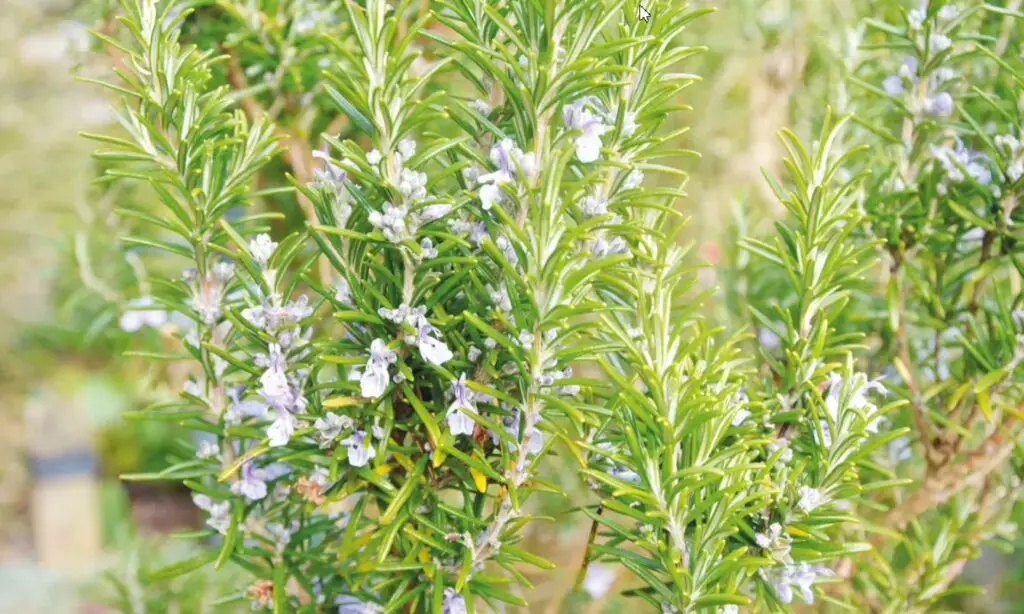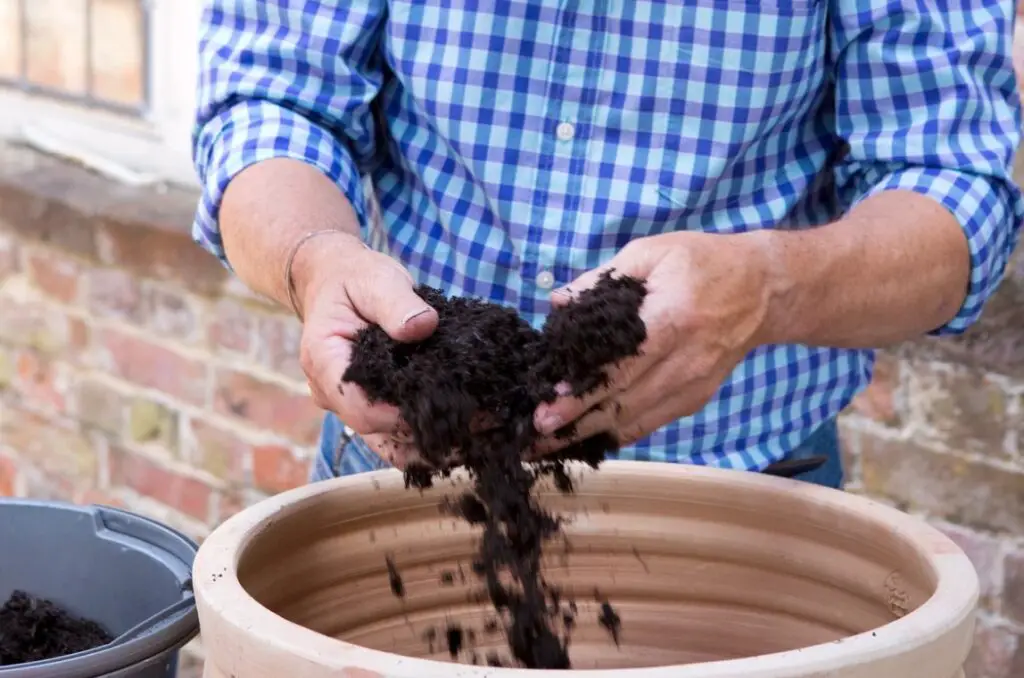I can say that this symptom is a fairly common problem that every gardener can face. They can be caused by a variety of reasons, and all of them carry a significant danger to the crop. Read more about the causes of white spots on rosemary in this article.

Contents
Irrigation with cold water
Watering rosemary bushes with cold water causes white spots on the rosemary. Cold water is known to stress the bushes. Using cold tap water can cause mineral deposits to build up and cause white spots.

You need to water the bushes with warm water. It is better to use filtered or settled water.
Pest infestation
The leaf surfaces of rosemary may become covered with white spots if the bushes have been affected by pests. You need to understand that insects can provoke a stunted growth of bushes, especially if you grow indoor plants. Rosemary leaves can be attacked by spider mites, aphids, and white flies.

Spider mites provoke white spots on rosemary leaves that resemble cotton. If you do not immediately deal with the fight against spider mites, rosemary bushes can completely die. You may notice white flies on the leaf surfaces that form on the underside of rosemary leaves.
Rosemary may encounter aphids, which suck moisture from the leaf surface.
Insects may vary in color. If treatment is not started immediately, insects can spread to other plants.
Pest control
To save rosemary and other plants from insects, you should use an insecticidal soap. You can also apply neem oil. The fight against pest eggs helps with a cotton pad soaked in rubbing alcohol. They need to wipe the leaf surface every week.
Powdery mildew
If you notice white spots on rosemary, chances are that powdery mildew is the cause. If you notice signs of disease on a rosemary plant, you need to work quickly, because this fungal disease spreads quite quickly.

The initial stage of powdery mildew on rosemary plants is presented as small white spots that visually resemble plaque caused by lime. The powder on the rosemary plant is composed of fungal spores that are quickly dispersed by the wind and fill the entire area.
Initially, disease on rosemary plants looks like an ordinary small spot. After the powdery mildew fungus begins to fill the bush and cover the entire rosemary plant.
Tiny fungal spores are the result of numerous fungal pathogens, so prevention is difficult.
If you notice disease in rosemary, the bushes do not die immediately. However, if you ignore powdery mildew, rosemary plants weaken. Photosynthesis slows down, which will cause growth retardation.
The main causative agents of the white powdery coating
It can be caused by several reasons, namely:
- Temperature regime. A powder coating develops on rosemary if the ambient temperature is between 60 and 86 degrees Fahrenheit.
- Moisture indicators. Powdery mildew develops on bushes if the humidity is high.
- Lack of sunlight. If rosemary plants are constantly in the shade, they are more likely to be affected by the disease. As soon as you start transplanting bushes to a more lit place, signs of powdery mildew disappear.
- Lack of air circulation. If rosemary is planted too closely, air circulation is poor. This increases the likelihood of developing a disease.

In most cases, powdery mildew spores can be seen in the warm season when the temperature is high. Rosemary is more likely to show signs of powdery mildew if there is a lot of rainfall, as humidity levels rise.
Features of the distribution of powdery mildew on rosemary
Powdery mildew on rosemary provokes a fungus, in particular, a filamentous fungus. Reproduction is carried out by the release of spores, which can be carried around the site by water and wind.

How to treat it?
For powdery mildew to spread less around the site, you need to make efforts to reduce the number of powdery mildew pathogens. You need to cut off the affected leaves on the rosemary. Use a sharp tool to remove the affected leaves of the rosemary plant.

It must first be disinfected using alcohol. You also have to consider repotting rosemary plants from a humid environment to areas where the air is drier and there is good ventilation. More details about the methods of treating disease are discussed later.
Using Neem Oil
The disease can be treated with organic fungicides in the form of neem oil. You can use a spray based on copper. Follow the manufacturer’s instructions when filling your spray bottle with neem powder anti-powdery mildew. Apply the neem oil remedy to the affected leaves, affecting both sides.

If you are going to treat disease with neem oil, then you need to use it correctly. Treatment of rosemary with neems oil should be carried out at intervals of several weeks until the symptoms disappear. If plants are in a dry environment, or if the air temperature is above 90 degrees Fahrenheit, neem oil spray is prohibited.
Baking soda
You can also use a baking soda solution to treat powdery mildew. The baking soda mixture changes the pH of the plant leaves surfaces, so fungi form in fewer numbers.

If rosemary leaves have been affected by the disease, then you need to treat rosemary leaves’ surfaces with a solution made from 1 gallon of water and 1.5 tablespoons of baking soda.
In the end, add a little insecticidal soap, and mix everything thoroughly. Pour the solution into a spray bottle, and start processing the infected plant. You can use this method of dealing with powdery mildew once a week.
Compost
If you notice infected plants with a disease on the site, then the fight can be carried out using a tea compost solution. If rosemary leaves have been affected by such a dangerous disease, water, and aged compost should be mixed. 5 parts of water require 1 part of the compost. After that, leave the solution for several weeks to infuse.

The solution should resemble the color of brewed tea. Use the compost tea solution every week during the growing season. It is necessary to use a compost tea solution for processing rosemary leaves until all symptoms of the disease are eliminated.
Preventing powdery mildew
To prevent the appearance of white spots on rosemary, which are caused by powdery mildew, you should take care of the quality care of the culture. Make sure that the circulation of the air is constant. Additionally, you can install a fan.

To prevent powdery mildew, prune rosemary plants that have become too bushy. Thanks to this, air circulation between rosemary leaves is improved. Constantly inspect the bushes in time to notice signs of powdery mildew.
If you are growing potted rosemary, place it on a windowsill.
To prevent powdery mildew, bushes should not be overloaded. Planting should be such that there is a distance of 2-3 feet between rosemary. It is important to reduce the use of fertilizers, which are high in nitrogen.
Sunburns
If rosemary bushes are exposed to the sun, they may experience sunburn, which causes stunted growth. In the future, the leaves may completely fade and fall off. To prevent sunburn, rosemary bushes should be placed in places where the sun penetrates only 6 hours a day.
Nutritional deficiency
If rosemary encounters nutrient deficiencies, it may cause white spots to form in the future.
If left untreated, rosemary leaves soon turn brown and die.
Therefore, fertilizers that contain a lot of nitrogen should be applied on an ongoing basis. If necessary, you can increase the dosage by 2 times. You can add compost to your growing soil.
FAQ
White spots on rosemary can cause plenty of questions.

How do you get rid of white spots on rosemary?
You can use a baking soda solution, which is a natural antiseptic.
Can you eat rosemary with powdery mildew?
Even though powdery mildew is not dangerous to humans, rosemary should not be eaten with powdery mildew. After all, this can cause allergies.
How do you treat powdery mildew on rosemary?
The treatment is to use baking soda. You can also use detergent and a little vegetable oil.
Why does my rosemary plant have spots?
The main causes of white spots on rosemary include powdery mildew, the use of cold water, and pests.
Results
As you can see, white spots on the bushes are very common. And you can deal with them only after determining the root cause.
If you need to read about how to harvest dill leaves, please read our article.



